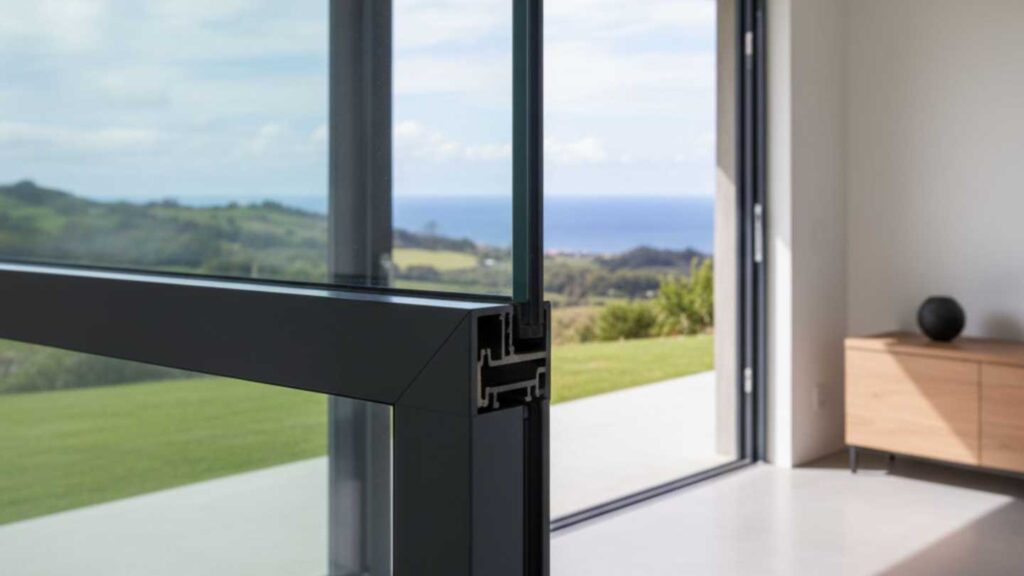When undertaking a new construction or a significant renovation, the selection of your fenestration system, that is, your windows and doors, is a defining decision. For both the architect, focused on performance specifications, and the homeowner concerned with security and comfort, the quality of the frames is paramount. Premium aluminium systems, such as those from Fenster, offer critical structural integrity and longevity.
Crucially, the glass itself determines the system’s performance. The glazing you specify or choose directly impacts a building’s energy efficiency, internal climate control, and passive security.
Selecting the right glass for your project’s environmental and security requirements is a high-stakes decision. It moves far beyond ‘standard pane.’ It requires understanding the various types of glass in windows and doors available to ensure the application-specific option is chosen. Let’s break down the main options and explore where they deliver the most value.
The Baseline: Annealed Glass (Standard Float)
The vast majority of glass begins as standard float, or annealed glass. This is the basic, clear glazing used where enhanced strength, certified safety, and high energy performance are not primary considerations.
Annealed glass is slowly cooled in a controlled process to relieve internal stress. However, its major drawback is its fracture pattern: when broken, it yields large, dangerous, jagged shards. Modern building codes and safety standards place severe restrictions on its application, particularly in high-traffic or low-level areas. For any contemporary, high-quality build, annealed glass is insufficient.
Specifying Types of Glass in Windows and Doors for Security and Safety
Given that the fenestration system is the building’s most vulnerable point, prioritising glass with enhanced protection is not optional; it is a mandatory specification for occupant well-being. This is defined by Safety glass, which primarily encompasses two engineered products: tempered and laminated glass.

1. Tempered Glass (Toughened)
Tempered glass is a thermally engineered product. Standard annealed glass is heated to approximately 700 °C and then rapidly cooled, inducing high compressive stresses on the surface.
Key Applications:
Mechanical Strength: It is four to five times stronger than standard glass and exhibits superior resistance to thermal stress and heat breakage.
Safety Assurance: Upon failure, it disintegrates completely into small, granular, blunt fragments, minimising the risk of serious injury.
Code Compliance: It is legally required in all zones prone to human impact, including all door glazing, shower enclosures, and any glazing installed below 800mm from the floor line.

2. Laminated Glass
Laminated glass is fabricated by permanently bonding two or more glass panes using a flexible polymer interlayer, most commonly Polyvinyl Butyral (PVB), under intense heat and pressure.
Key Applications:
Passive Security: Lamination is the preferred specification for forced-entry resistance. If the glass is structurally broken, the PVB layer holds all fragments in place within the frame. This significantly delays or outright denies immediate access to intruders, acting as a powerful deterrent.
Acoustic Performance: The inner plastic interlayer is an exceptional sound-dampening element, making laminated glass an excellent choice for mitigating noise transmission near busy environments.
Interior Preservation: The PVB layer inherently blocks up to 99% of the sun’s Ultraviolet (UV) radiation, protecting internal finishes, textiles, and artwork from sun damage and fading.
In a premium aluminium system, both Tempered and Laminated glass are highly durable. However, for ground-floor vulnerability points, laminated glass provides the essential added security layer.
The Performance Factor: Insulated and Coated Glazing
Moving beyond structural and security concerns, glass choice is a major determinant of a building’s long-term energy profile and internal climate quality.
Insulated Glass Units (IGU / Double Glazing)
An IGU is a factory-sealed assembly of two or more glass panes separated by a gas-filled cavity (often Argon or dehydrated air (Dry Air) held apart by a spacer bar. This trapped, inert layer significantly reduces the conduction of heat and cold.
Key Applications:
Thermal Regulation: Double glazing drastically reduces thermal transfer compared to single glazing. It minimises heat gain during warm periods and heat loss during cold periods, leading directly to lower operational heating, ventilation, and air conditioning (HVAC) costs.
System Integrity: IGUs are a foundational component in energy-efficient building designs, helping projects achieve stringent thermal performance standards.
Low-E (Low-Emissivity) Glass
This is a functional enhancement, not a distinct type of glass. It involves a microscopically thin, virtually transparent metallic oxide coating applied to a glass surface, usually within the IGU cavity. This coating reflects thermal energy (infrared light).
Key Applications:
Optimised Solar Control: In sunny climates, the Low-E coating reflects the sun’s heat-carrying short-wave energy outward, preventing solar heat gain. In colder climates, it reflects the building’s heat-carrying long-wave energy inward, maximising warmth retention.
Energy Code Compliance: Specifying an IGU with a Low-E coating is the most effective way to meet or exceed building codes regarding thermal efficiency.
Comparison Table: Glazing Specifications
To assist in the specification process, here is an overview of the most common types of glass in windows and doors:
Glass Type | Core Benefit | Security Feature | Energy Efficiency | Typical Application |
Annealed (Float) | Basic Light Transmission | Low (Shatters into sharp, dangerous shards) | Low | Limited to non-critical, high-level, or utility areas |
Tempered | High Mechanical Strength | High (Shards are small and blunt) | Low to Medium | Safety-critical areas: Shower units, balustrades, large door panels |
Laminated | Intact Post-Breakage | Excellent (Held together by PVB interlayer) | Medium (High when combined with Low-E) | Security glazing, noise-sensitive applications, UV protection |
IGU with Low-E | Superior Thermal Insulation | Dependent on the inner/outer pane type (Laminated recommended) | Excellent | All main living areas, high-performance commercial and residential projects |

The Perfect Pairing: Performance Glass Demands a Premium Frame
The technical performance of glass, be it a high-R-value Low-E IGU or certified Tempered and Laminated glass, is intrinsically tied to the quality of the frame system it is housed within.
A window or door frame that lacks precise engineering, quality gaskets, or structural rigidity will inevitably fail. Air and water infiltration around a poor frame negates the benefits of expensive thermal glass and immediately compromises security.
Fenster’s premium aluminium window and door systems are precision-engineered to accommodate the weight, depth, and demanding performance requirements of modern, high-specification glazing. We provide the essential synergy between a robust frame and high-performance glass, delivering a complete system that meets the elevated standards required by both architectural specifications and end-user expectations.
Ready to elevate your project with the definitive balance of premium aluminium and high-performance Safety glass?
Do not compromise the integrity of your build with inadequate glazing or hardware. As a leader in premium aluminium windows and doors, Fenster provides the expert systems and guidance necessary to select and install the ideal glass specification for any construction project.
Contact the Fenster team today to consult on your glazing needs or explore our range of precision-engineered, high-quality aluminium window and door systems.

